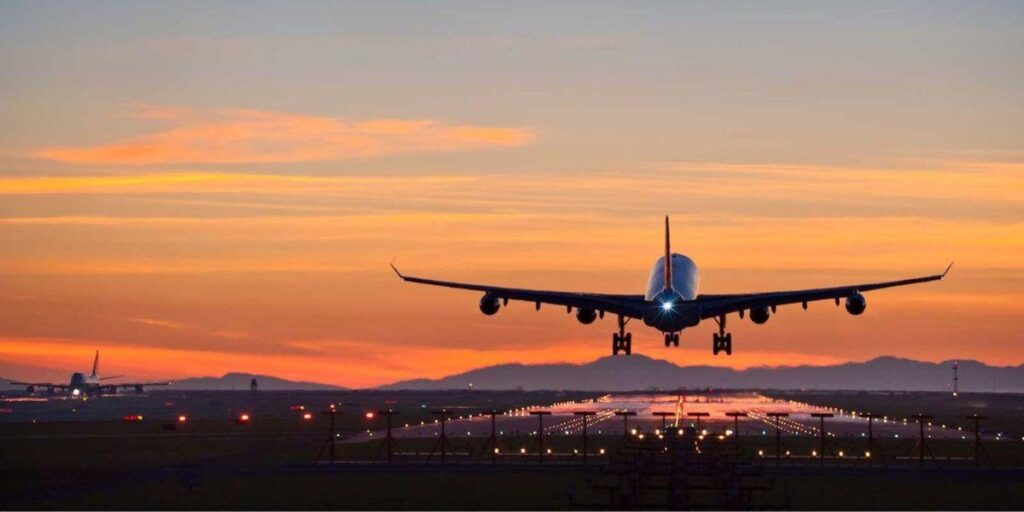Airlines add seasonal flights as Dubai–Chandigarh (IXC) capacity rises, marking another strong chapter in India–UAE air connectivity. With travel demand peaking during the winter and festive seasons, carriers are expanding routes and frequencies to meet the needs of both tourists and expatriates. The Dubai–Chandigarh sector, once served by limited flights, is now emerging as one of the most dynamic regional routes connecting North India with the Gulf. This expansion reflects not only the strong cultural and economic ties between the two destinations but also a broader post-pandemic revival in aviation. Families, business travelers, and leisure tourists are all contributing to the surge in bookings, while airlines are positioning themselves to capture this momentum with new aircraft, added frequencies, and improved onboard experiences.
Growing Passenger Demand Drives Route Expansion
The UAE remains one of the most popular international destinations for Indian travelers. With Dubai being a global hub for tourism, trade, and employment, the flow of passengers from northern Indian cities such as Chandigarh, Amritsar, and Delhi has grown steadily. The rising capacity on the Dubai–Chandigarh route is a direct response to this growing demand. Industry insiders note that the route’s popularity has spiked particularly during festive months — from Diwali to the New Year season — when families travel to reunite or explore Dubai’s shopping and cultural offerings. For many North Indians, especially from Punjab and Haryana, the direct link between Chandigarh and Dubai has become a convenient gateway to the Middle East. Airlines such as IndiGo, Air India Express, and flydubai are leading the charge, announcing additional flights and upgraded schedules to accommodate travelers. These seasonal boosts not only support tourism but also help strengthen trade and personal connections between the two regions.
The Strategic Importance of Chandigarh as a Gateway
Chandigarh, the joint capital of Punjab and Haryana, is not just a planned city of administrative importance but also a fast-developing aviation hub for North India. Its strategic location allows travelers from Punjab, Himachal Pradesh, and even parts of Jammu & Kashmir to access international destinations conveniently. The increase in Dubai-bound flights is therefore a logical extension of its growing prominence. For many residents in this belt, flying from Delhi is no longer the only option. With the Dubai–Chandigarh route offering direct access to the UAE, travelers save both time and costs. Moreover, the region’s significant diaspora presence in the Gulf fuels consistent two-way traffic. Many expatriates from Punjab and Haryana prefer returning home via Chandigarh, as it connects them directly to their roots without the additional domestic travel. This demand has encouraged both low-cost and full-service carriers to strengthen their foothold in the market, viewing Chandigarh as a high-potential origin point for Gulf-bound traffic.

Airlines Adjust Strategies for Seasonal Peaks
Seasonal flight additions are not just about numbers — they reflect strategic planning. Airlines often deploy additional capacity during months when travel surges due to holidays, school breaks, or major cultural events. For the Dubai–Chandigarh route, this includes the Diwali season, Christmas holidays, and Dubai’s peak tourism period from November to February. During these months, carriers like flydubai and Air India Express typically add frequencies, operate larger aircraft, or introduce new departure timings to suit traveler preferences. The growing participation of Indian low-cost carriers also plays a key role. IndiGo, for example, continues to strengthen its UAE connections with flexible pricing and improved scheduling, offering passengers better connectivity options and affordability. These adjustments contribute to a smoother travel experience and higher passenger satisfaction, which in turn boost loyalty and repeat bookings.
The Economic Impact of Expanding Air Connectivity
Beyond tourism, the rising capacity between Dubai and Chandigarh carries significant economic implications. Increased connectivity encourages trade, supports small businesses, and promotes investment opportunities across both markets. Dubai serves as a key re-export hub for goods such as textiles, jewelry, electronics, and agricultural products from India’s northern states. The easier movement of people and goods translates into stronger commercial partnerships and employment generation. Furthermore, enhanced flight availability helps boost regional tourism within the UAE. Many travelers from Punjab and neighboring regions visit Dubai for its world-class shopping festivals, theme parks, and cultural experiences. As the Dubai Shopping Festival 2025 approaches, airlines expect record passenger volumes from India’s northern regions. In return, the UAE’s residents visiting India contribute to the hospitality and retail sectors in cities like Chandigarh, Shimla, and Amritsar — creating a two-way benefit that stimulates both economies.

Dubai’s Growing Role as a Global Transit Hub
Dubai International Airport (DXB) remains one of the busiest airports in the world, connecting over 200 destinations globally. For travelers from northern India, it serves as a vital transit point to Europe, Africa, and North America. The expansion of flights from Chandigarh enhances Dubai’s positioning as a preferred stopover destination. Passengers can now enjoy shorter layovers and better connection options on global airlines such as Emirates, flydubai, and partner carriers. Additionally, Dubai’s seamless visa-on-arrival process for Indian travelers and growing reputation as a family-friendly destination make it an attractive option. The city’s modern infrastructure, luxurious hospitality, and year-round events keep it firmly on the radar of Indian tourists.
Airlines Focus on Enhanced Passenger Experience
As competition intensifies on the Dubai–Chandigarh route, airlines are increasingly focused on enhancing the passenger experience. This includes improved in-flight services, flexible ticket options, and digital check-in solutions that simplify the travel process. For budget-conscious travelers, low-cost carriers are offering competitive fares and promotional bundles, while premium carriers continue to emphasize comfort, culinary offerings, and entertainment options. Airlines like flydubai are known for connecting regional Indian cities to Dubai with Boeing 737 MAX aircraft, ensuring modern cabins and efficient service. Air India Express, on the other hand, continues to attract loyal passengers with its direct connectivity and reliability. These improvements signal a broader shift in the aviation landscape — where travelers expect both affordability and quality, and airlines must innovate to meet these expectations.
Strengthening UAE–India People-to-People Ties
The expansion of seasonal flights also deepens the human connection between the UAE and India, especially among expatriates who form a vital part of the UAE’s population. More than 3.5 million Indians live and work in the UAE, contributing significantly to its economy and social fabric. Many of them come from northern Indian states like Punjab, Haryana, and Himachal Pradesh, making Chandigarh a natural hub for family visits and homecomings. Additional flights mean easier reunions, shorter waiting periods, and more convenience during peak travel times. Furthermore, with the rise of remote work and flexible business models, professionals are increasingly traveling between India and Dubai for hybrid work arrangements, cross-border projects, and startup collaborations. Enhanced connectivity supports this growing trend and keeps bilateral engagement vibrant.
The Festive Season Boost and Tourist Travel
As the festive season unfolds, Dubai becomes a magnet for Indian travelers. From shopping and dining to entertainment and events, the city’s attractions draw thousands of visitors every week. Airlines see a notable spike in bookings during Diwali, Christmas, and New Year’s Eve, prompting them to scale up operations. The Dubai Shopping Festival, Global Village, and New Year celebrations at Burj Khalifa are among the top experiences sought by Chandigarh-based travelers. With additional flight options, more families and groups can now plan short holidays without the hassle of long transits or high last-minute fares. This surge also benefits the tourism ecosystem in Dubai — from hotels and restaurants to retail and transport services — further solidifying the city’s position as a global leisure capital.

Infrastructure Upgrades and Airport Efficiency
The rise in passenger traffic between Dubai and Chandigarh has prompted infrastructure upgrades at both ends. Dubai International Airport continues to enhance its terminal facilities and immigration efficiency, while Chandigarh International Airport has expanded its customs and check-in areas to handle higher international volumes. The introduction of e-gates, digital baggage systems, and automated boarding procedures at both airports ensures smoother travel. Airlines are also coordinating closely with airport authorities to align scheduling and reduce congestion during peak times. Such infrastructural advancements not only improve operational efficiency but also make the overall flying experience more seamless and enjoyable for travelers.
The Future of the Dubai–Chandigarh Route
Industry experts predict that the Dubai–Chandigarh route will continue to grow even beyond the seasonal rush. The consistent demand for leisure, business, and family travel between the UAE and northern India suggests the potential for permanent additional frequencies or new entrants to the market. If the upward trend continues, more carriers may explore connecting secondary Indian cities directly to Dubai, following Chandigarh’s success story. This would diversify access points for travelers and support the UAE’s vision of becoming the region’s most connected aviation hub. In the longer term, this expansion will also contribute to regional economic growth, tourism development, and cultural exchange — reinforcing the mutual partnership that defines UAE–India relations.
Conclusion: A Season of Connection and Growth
The addition of seasonal flights and the rise in Dubai–Chandigarh (IXC) capacity highlight the growing vibrancy of air travel between India and the UAE. It is not merely about routes and schedules — it’s about people, progress, and partnerships. As airlines race to meet the surging demand, travelers gain better access, affordability, and flexibility. For families celebrating festivals, businesses exploring opportunities, or tourists seeking adventure, the strengthened air corridor between Dubai and Chandigarh offers convenience and connection like never before. Ultimately, this development reflects the shared aspirations of two regions bound by heritage, opportunity, and trust. The skies between Dubai and Chandigarh are busier — and brighter — than ever, signaling a future of continued collaboration and growth.
Do follow UAE Stories on Instagram
Read Next – Italy Showcases Power and Innovation at UAE’s ADIPEC 2025














